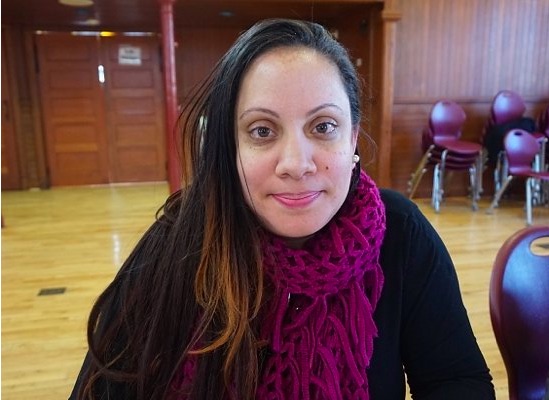TOLERANCE AND SOLIDARITY .
an article by Aliyya Swaby, New Haven Independent
While giving a presentation in a high school classroom, Lola Garcia-Blocker had to ask a student being particularly disruptive to leave the room. Instead of sulking or causing a ruckus, the student left calmly—and later sought her out to apologize for misbehaving.

Velazquez: Students should learn to self-advocate.
That is what it looks like, Garcia-Blocker said, when a school successfully implements a culture of “restoration” instead of punishment. The student “repaired” the harm by asking for forgiveness and restored his relationship with a member of the community. Garcia-Block, the Board of Ed’s “career pathways director,” is part of a working group designing a “restorative practices” plan as a better way to deal with discipline problems in New Haven’s schools.
After delving into the district’s existing code of conduct for a few meetings, the working group got their first lesson this past Thursday in how schools can go about creating that culture while breaking an existing “cycle of fear.”
The ultimate goal of the group is figure out how to decrease suspensions and expulsions while increasing methods such as peer mediation that “restore” the offender’s relationship with the school community. The teachers union received a $300,000 grant to implement restorative practices in a handful of public schools, part of a larger city initiative to keep troubled kids in school instead of pushing them out into violence.
Kyisha Velazquez, who has for eight years headed the district’s juvenile review board, gave a short presentation on the philosophy of restorative justice to get all members of the working group on the same page. Velazquez has been working since the fall at King/Robinson School to implement restorative programs to help “kids who have struggled the most in school.” Instead of just suspending or expelling those students, school staff creates circles—of “victims,” “offenders” and the whole community—to “process with them over and over and over their behavior that has harmed the community,” she said.
Ultimately, schools should aim to turn a “cycle of fear” into a “cycle of hope,” in which members who harm others then go through a process of building community, leading to a stronger fabric that prevents future harm, Velazquez said. Students work on an action plan based on three questions: what is the harm, how can it be repaired and who is responsible for carrying out that repair?
The student who disrupted Garcia-Blocker’s classroom could have also repaired the harm indirectly done to the rest of the students, she said. When someone acts out and agrees to restorative action, someone needs to “take on the task of holding him accountable to finish” carrying out those actions, Velazquez said. “If not, that’s where the disconnect is.”
Restorative practices include restitution, reparation boards, community services, family group conferencing, letters of apology, circle sentencing and victim/offender mediation— implemented in a way that is “all-inclusive,” she said.
(This article is continued in the discussion board on the right side of this page.)
Restorative justice, What does it look like in practice?
(Article continued from left side of this page.)
In a recent case, a student’s father, in a fit of road rage, chased down a fellow driver who cut him off, while the student was in the back seat. The other driver and the student’s sibling got into a physical fight. The student hit the driver in the head. Velazquez said it was clear that the student was in the wrong, but “also the dad has some issues.” Family conferencing was necessary in order to address the root of the problem.
In another situation, several kids attacked a neighbor who was chronically ill. Through a juvenile review board, it was decided that the students would help the woman clean and take out her trash, as community service to repair the harm done by the attack.
Velazquez said this was restorative for the whole neighborhood, since the situation could have otherwise escalated and posed a larger danger.
Parent Megan Ifill said restorative practices also help when students are expelled from one school and placed in another. They can “process professionally why they have to go to another school” before starting anew somewhere else, she said.
And involving the student in the process of determining what the harm is helps prevent future harm, she said.
“A lot of kids don’t know why they’re saying sorry,” she said. “In your process, you take what the kid is willing to be sorry for” and repair that harm done. The student might not be sorry for having hit someone, but might be sorry for forcing his or her parents to take time off work to deal with the situation, for example.
Garcia-Blocker reminded the group that students are not the only ones who may benefit from restorative practices. Adults should also be held responsible if they harm others in the school community. “We have adults in our school … that escalate situations” and want to call the police when students act out, she said. She urged group members to change their language to reflect that reality.
Kids “crave” the healing that comes with restoration, said parent JoAnne Wilcox. She said she uses some of those practices in her own home, in order to move away from a system of punishment and rewards.
Velazquez said she has also been working with students to help them advocate for themselves in situations where they may not be at fault.
At the next meeting, according to Gemma Joseph Lumpkin, executive director for district strategy and coordination, the group will discuss a transcript of an expulsion hearing.